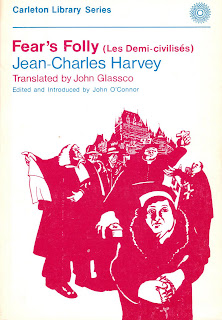
The Four Jameses
William Arthur Deacon
Toronto: Macmillan, 1974
A bit of a risk acknowledging National Poetry Month on a day when people are looking-out for hoaxes and practical jokes. I double the hazard by focusing on this book, with its lousy cover and cheap sales pitch. The whole thing looks a bit fake - but, as George Fetherling (then Doug) notes, Deacon's book is 'that rare thing in Canadian literature: an underground classic.' As is often the fate of titles that fall into this category, The Four Jameses has had an unusual history. First issued as a hardcover in 1927, its publisher, Graphic, was felled by the Depression. After a period in limbo, unbound sheets were bought and issued in paper wraps. In 1953, Ryerson published a revised edition, which was followed, a little over two decades later, by this Macmillan paperback. With one publisher done in by hard times, and the others victims of manifest destiny, you'd almost think that The Four Jameses was cursed. Still, I keep it on my shelves.
Deacon's book centres on James Gay, James McIntyre, James D. Gillis and James MacRae, four poets of the late 19th and early 20th centuries. They are, as Fetherling points out, united by Christian name, nationality and sheer lack of talent. That said, I'm quick to express my doubts that they are 'Canada's Four Worst - And Funniest - Poets', as claimed on the cover. True, their work can raise a smile or two, but I've read much worse.
Of the four, I prefer James MacRae (né John James MacDonald), who published his first book of verse, Poems written by J. J. MacDonald, a Native of Glengarry, in or about 1877. Deacon is good enough to provide several lines from this extremely rare book, including:
How oft thus lay the secret way
In which the game is played:-
A shapely mass, by name a lass,
Is artfully arrayed.
Is neatly bound with metal round
And trimmings wisely made,
And padded o'er with worthless store
To cover unbetrayed
The sad defects, which one detects
When nature is displayed.
Forty-six years elapsed between the poet's debut and his second book, An Ideal Courtship. Published in 1923 under the nom de plume James MacRae, it is described by Deacon as the poet's magnum opus. An Ideal Courtship is a long narrative poem telling of the company kept between Mary Campbell, formed by her parents as a chaste 'model for the public to admire', and William Chisholm, a stick-in-the-mud farmer from the Maritimes. There doesn't appear to be much amour or ardor in this poem. In MacRae's world, an ideal courtship ends not at the altar, but the grave:
Mary suddenly took sick, and human skill could find no relief
Render her in her distress, which made the tragic struggle brief.
But, wait, a few days later the grief-stricken William is found dead, lying on his fiancée's grave:
Though so often disappointed by events beyond their power.
They were finally reunited at their own appointed hour.
But so well their lives were ended, and so holy was their love,
We may hope that they were married at the altar steps above.
MacRae didn't let another 46 years pass before publishing his next book. A septuagenarian, how could he? His Poems and Essays was published in 1930.
Sadly, The Four Jameses provides little biographical information about MacRae. Deacon tells us that the poet was born in 1849 in what was then Alexandria, roughly 40 kilometres north of Cornwall, Ontario. In 1875 he arrived in St Marys, Ontario, and was living in the town when his first volume was published. It seems MacRae stayed in St Marys for about a decade, before settling out to farm in parts unknown. According to Deacon, in 1918 the poet returned to St Marys, 'where he spent a pleasant old age, and where the Public Library was an unfailing source of enjoyment... Among the townspeople he was reported to be mildly eccentric, which probably means nothing more than a strongly marked personality intensified by a touch of the artistic temperament, without which no poet is properly equipped.'
Here I admit that my preference for MacRae is influenced by my move to this pretty little town last year. I, too, have found the library to be an 'unfailing source of enjoyment' - though, I regret to report, it contains not a single volume of MacRae's verse. Nor does it have a copy of The Four Jameses.

St Marys Public Library
Object: We all live on a yellow hunk of cheese... I can't imagine how many people were turned away by the cover. Fairly typical of Macmillan's paperbacks, at 35 it's holding up quite well.
Access: The Four Jameses is readily available in our larger public libraries, most often in the Macmillan edition. The Graphic Publishers first is by far the most attractive, and includes illustrations and photos not found in the others. Nice copies of the cloth and paper editions can be found for under C$30. The Ryerson edition, the least desirable, can be had for C$20. Macmillan's 1974 edition benefits from Fetherling's informative Introduction. Curiously, it's the least common of the three - only two copies are currently listed online: one going for US$11, the other at US$59.85 (on offer from an optimistic bookseller in Little Elm, Texas).



























